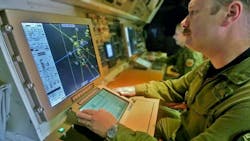Signal Systems Corp. to develop enabling technologies for anti-submarine warfare (ASW) airborne sonar
LAKEHURST, N.J. – U.S. Navy anti-submarine warfare (ASW) experts needed a company to prototype systems for airborne ASW and undersea warfare research. They found their solution from Signal Systems Corp. in Millersville, Md.
Officials of the The Naval Air Warfare Center Aircraft Division in Lakehurst, N.J., announced a $13.5 million order to Signal Systems this week to develop new enabling technologies for difficult ASW problems.
Signal Systems experts will move forward with three Small Business Innovation Research (SBIR) projects called Continuous Active Sonar Signal Processing; Target Localization Using Multi-Static Sonar with Drifting Sonobuoys; and Spread Spectrum Techniques for Sonar Ping Technology.
Continuous active sonar signal processing involves relatively low-power active sonar to detect enemy submarines, rather than a relatively high-power pulse-type sonar approach, which can be harmful to marine mammals like whales.
Instead, Signal Systems experts are investigating low-power continuous-wave sonar approaches with the same ASW detection and tracking capability as higher-power systems. Continuous-wave sonar also may enable continuous tracking for accurate localization of submarines.
Continuous-wave sonar also has the potential to exploit Doppler effects more completely than pulse-type sonar, Navy officials say. Signal Systems's approach emphasizes sonar signal processing for continuous active sonar to help the Navy address the risks of self-jamming, blind speed, and tracking issues.
The company also is developing waveforms, direct-blast cancellation, space-time adaptive, and track-before-detect algorithms for continuous-wave sonar operation.
Airborne target localization using multi-static sonar with drifting sonobuoys seeks to develop technologies for quick and accurate sonobuoy location for future multi-static search systems and data fusion techniques. Obsolete methods of buoy location based assuming the target will be held in contact for significant periods, will not work, Navy researchers point out.
Signal Systems engineers are developing techniques to locate source and receiver sonobuoys by using only acoustic data from drifting active and passive buoys, without the use of other data.
Spread spectrum techniques for sonar ping technology seeks to reduce peak power to improve detection performance while reducing the power requirements and the impact on marine life, as well as improve active sonar detection performance by improving time-bandwidth gains received signal to noise ratio.
This order calls for Signal Systems to move forward with developing acoustic ASW sensors and systems; telemetry and recording systems; signal and data processing; algorithm development; mathematical modeling; system and application prototyping; active and passive display enhancements; information assurance, anti-tampering and cyber security concepts; and techniques and analysis to predict the performance of ASW systems.
Signal Systems will do the work in Millersville and in Lexington Park, Md., and should be finished by July 2025. For more information contact Signal Systems Corp. online at www.signalsystemscorp.com, or the Naval Air Warfare Center Aircraft Division-Lakehurst at www.navair.navy.mil/lakehurst.
About the Author
John Keller
Editor-in-Chief
John Keller is the Editor-in-Chief, Military & Aerospace Electronics Magazine--provides extensive coverage and analysis of enabling electronics and optoelectronic technologies in military, space and commercial aviation applications. John has been a member of the Military & Aerospace Electronics staff since 1989 and chief editor since 1995.
